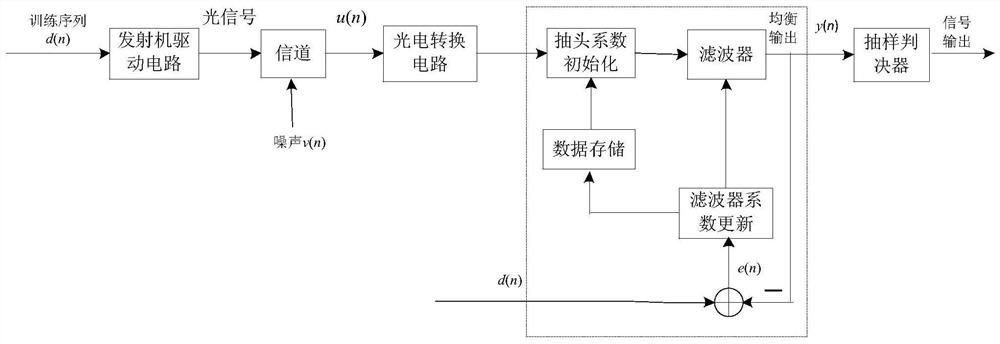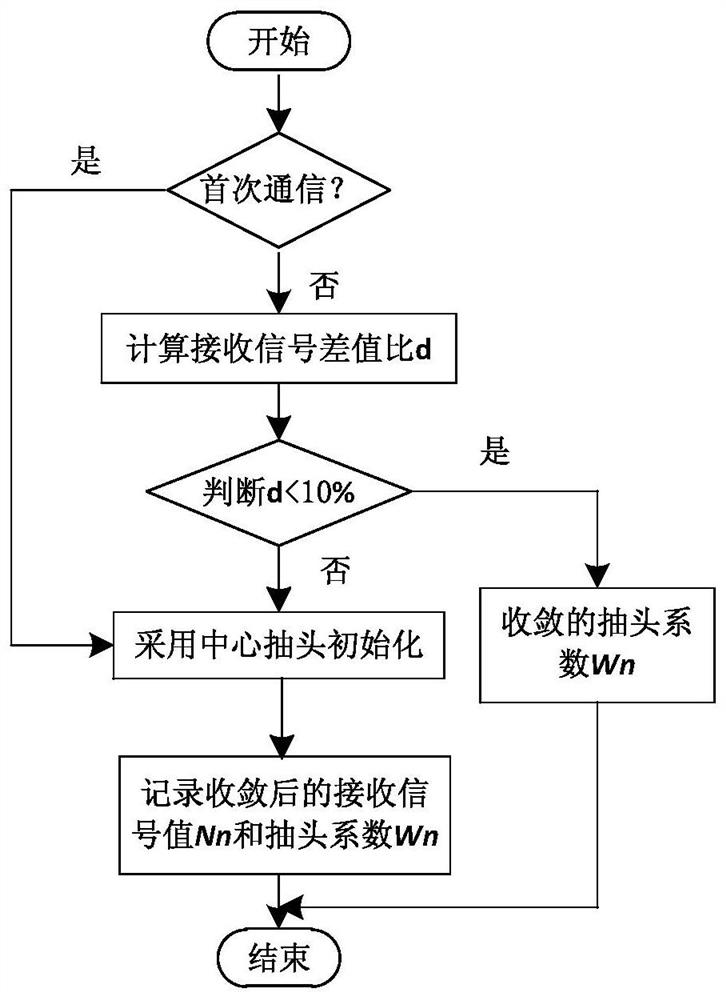A Visible Light Communication System Based on Sinusoidal Function Variable Step Size LMS Equalization
A technology of visible light communication and sine function, which is applied in the direction of short-distance systems and free space transmission. The effect of fast coefficient and small amount of calculation
- Summary
- Abstract
- Description
- Claims
- Application Information
AI Technical Summary
Problems solved by technology
Method used
Image
Examples
Embodiment 1
[0040] 1. The equalizer in the visible light communication system of the present invention includes two parts: a digital filter and an adaptive algorithm. Among them, the digital filter adopts a finite impulse response filter structure, and the adaptive algorithm adopts a least mean square (LMS) algorithm.
[0041] 2. The training sequence d(n) drives the LED to emit light through the transmitter drive circuit, and converts the electrical signal into an optical signal. After the optical signal enters the VLC channel, it is affected by inter-symbol interference and random noise v(n), and the output signal is u( n)=d(n)h(n)+v(n).
[0042] 3. In the process of signal processing, the input signal u(n) is first multiplied by the tap coefficient W(n) and summed to obtain the output signal y(n) of the filter, and then the expected signal d(n) and The output signal y(n) is subtracted to obtain the error signal e(n); then, the mean square error function required by the adaptive algori...
Embodiment 2
[0050] The visible light communication system of the present invention such as figure 1 As shown, the training sequence d(n) drives the LED to emit light through the transmitter drive circuit, and converts the electrical signal into an optical signal; after the optical signal enters the VLC channel, it is affected by inter-symbol interference and random noise v(n), and the output signal is u (n)=d(n)h(n)+v(n); then the signal u(n) passes through the photoelectric conversion circuit to convert the optical signal into an electrical signal; the electrical signal is used as the input signal of the equalizer, and the equalizer passes through the The received electrical signal is equalized so as to compensate for the visible light communication channel; the equalized electrical signal can accurately restore the original training sequence d(n) through a sampling judgment circuit. The equalizer adapts to the change of the VLC channel, and the tap coefficient reaches the optimal value ...
specific Embodiment approach
[0052] The specific implementation manner of equalizing the input signal by the equalizer in the visible light communication system is as follows:
[0053] Step 1: Initialize the tap coefficient W of the equalizer, adopt the center tap initialization method, that is, the middle tap coefficient is 1, and the rest are 0;
[0054] Step 2: Multiply the input signal u(n) by the tap coefficient W(n) to obtain the output signal y(n).
[0055]
[0056] In the formula, N is the order number of the equalizer; W is the tap coefficient.
[0057] Step 3: Subtract the expected signal d(n) from the output signal y(n) to obtain the error signal e(n).
[0058] e(n)=d(n)-y(n)
(2)
[0059] Step 4: Construct the mean square error function required by the adaptive algorithm through the error signal e(n).
[0060] J=e 2 (n) (3)
[0061] Step 5: According to the basic principle of variable step size, construct the nonlinear sine function of step size factor μ(n) and error signal e(n), the ...
PUM
 Login to View More
Login to View More Abstract
Description
Claims
Application Information
 Login to View More
Login to View More - R&D
- Intellectual Property
- Life Sciences
- Materials
- Tech Scout
- Unparalleled Data Quality
- Higher Quality Content
- 60% Fewer Hallucinations
Browse by: Latest US Patents, China's latest patents, Technical Efficacy Thesaurus, Application Domain, Technology Topic, Popular Technical Reports.
© 2025 PatSnap. All rights reserved.Legal|Privacy policy|Modern Slavery Act Transparency Statement|Sitemap|About US| Contact US: help@patsnap.com



